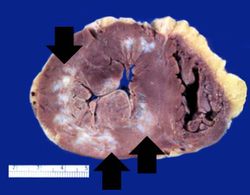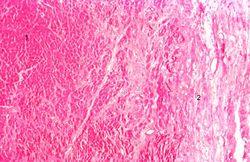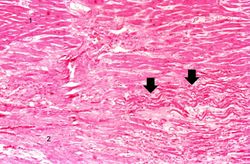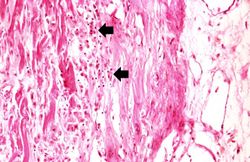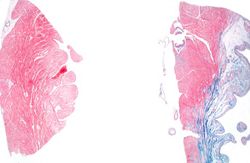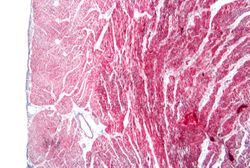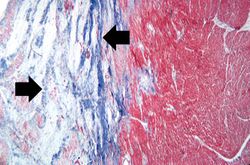Difference between revisions of "IPLab:Lab 3:Healed Myocardial Infarction"
Seung Park (talk | contribs) (Created page with "== Images == <gallery heights="250px" widths="250px"> File:IPLab3HealedMyocardialInfarction1.jpg|This is a gross photograph of a heart with areas of old healed myocardial infa...") |
Seung Park (talk | contribs) |
||
| (9 intermediate revisions by the same user not shown) | |||
| Line 1: | Line 1: | ||
| + | == Clinical Summary == | ||
| + | This 37-year-old white female with a 22 year history of insulin-dependent diabetes was admitted to the hospital 10 hours prior to death complaining of chest pain and shortness of breath. Three months before, she had begun to experience progressive weakness and for the previous 3 weeks she noticed increasing dyspnea on exertion and worsening of a chronic cough. | ||
| + | |||
| + | == Autopsy Findings == | ||
| + | Autopsy showed a 340-gram heart with extensive transmural reddish discoloration of the anterolateral portion of the myocardium of the left ventricle. There was severe atherosclerotic narrowing of all coronary arteries especially the left anterior descending. The lungs showed pulmonary edema and early bronchopneumonia. | ||
| + | |||
== Images == | == Images == | ||
<gallery heights="250px" widths="250px"> | <gallery heights="250px" widths="250px"> | ||
| Line 10: | Line 16: | ||
File:IPLab3HealedMyocardialInfarction8.jpg|This is a higher-power photomicrograph of a trichrome-stained section of heart containing an old healed MI. The scar tissue (mature fibrous connective tissue) is stained blue. | File:IPLab3HealedMyocardialInfarction8.jpg|This is a higher-power photomicrograph of a trichrome-stained section of heart containing an old healed MI. The scar tissue (mature fibrous connective tissue) is stained blue. | ||
</gallery> | </gallery> | ||
| + | |||
| + | == Virtual Microscopy == | ||
| + | === Early (Inflammatory Response) === | ||
| + | <peir-vm>IPLab3HealedMyocardialInfarction_A</peir-vm> | ||
| + | |||
| + | === Late (Replacement Fibrosis) === | ||
| + | <peir-vm>IPLab3HealedMyocardialInfarction</peir-vm> | ||
| + | |||
| + | == Study Questions == | ||
| + | * <spoiler text="Why does this 37-year-old woman have such severe coronary atherosclerosis?">Diabetes mellitus is a major risk factor for developing premature atherosclerosis.</spoiler> | ||
| + | * <spoiler text="Why are there areas of acute myocardial injury in the section of myocardium from the patient with the old healed myocardial infarction?">This finding is very common in areas adjacent to an old infarction. If you remember from previous cases, there were areas of vacuolar change adjacent to the acute infarct. The areas adjacent to an infarct may still be alive but they will be at risk for additional ischemic insult. In this current case, the patient had several serious medical problems which may have caused hypotension and poor perfusion to the heart. Thus, the areas of risk could have been damaged leading to acute myocardial necrosis.</spoiler> | ||
| + | * <spoiler text="What is the time course of the normal inflammatory response after a myocardial infarction?">Few morphologic changes occur in the heart until approximately 6 to 12 hours after coronary occlusion. Subtle changes such as hypereosinophilia, coagulation necrosis and wavy fiber change can be seen during this early time period. If there is reperfusion of the myocardium there may be contraction band necrosis as well. | ||
| + | |||
| + | By two to three days there is an acute inflammatory cell infiltrate comprising primarily neutrophils. | ||
| + | |||
| + | At 5 to 10 days macrophages come in to phagocytose the necrotic myocardial tissue. As the dead tissue is being phagocytosed by macrophages, fibroblasts and blood vessels begin to grow into the area of infarction and form granulation tissue. | ||
| + | |||
| + | Fibroblasts lay down collagen and by two to three months the infarct is replaced by matured collagenous "scar" tissue.</spoiler> | ||
| + | |||
| + | == Additional Resources == | ||
| + | === Reference === | ||
| + | * [http://emedicine.medscape.com/article/155919-overview eMedicine Medical Library: Myocardial Infarction] | ||
| + | * [http://www.merckmanuals.com/professional/cardiovascular_disorders/coronary_artery_disease/acute_coronary_syndromes_acs.html Merck Manual: Acute Coronary Syndromes] | ||
| + | |||
| + | === Journal Articles === | ||
| + | * Yuan S, Liu Y, Zhu L. [http://www.ncbi.nlm.nih.gov/pubmed/10626065 Vascular complications of diabetes mellitus]. ''Clin Exp Pharmacol Physiol'' 1999 Dec;26(12):977-8. | ||
| + | |||
| + | === Images === | ||
| + | * [{{SERVER}}/library/index.php?/tags/43-myocardial_infarct PEIR Digital Library: Myocardial Infarct Images] | ||
| + | * [http://library.med.utah.edu/WebPath/CVHTML/CVIDX.html WebPath: Cardiovascular Pathology] | ||
| + | |||
| + | == Related IPLab Cases == | ||
| + | * [[IPLab:Lab 1:Myocardial Infarction|Lab 1: Heart: Myocardial Infarction (Coagulative Necrosis)]] | ||
| + | * [[IPLab:Lab 3:Acute Myocardial Infarction|Lab 3: Heart: Acute Myocardial Infarction]] | ||
| + | * [[IPLab:Lab 4:Mural Thrombus|Lab 4: Heart: Mural Thrombus]] | ||
| + | * [[IPLab:Lab 4:Thrombosis|Lab 4: Coronary Artery: Thrombosis]] | ||
| + | * [[IPLab:Lab 4:Pulmonary Congestion and Edema|Lab 4: Lung: Pulmonary Congestion and Edema]] | ||
{{IPLab 3}} | {{IPLab 3}} | ||
[[Category: IPLab:Lab 3]] | [[Category: IPLab:Lab 3]] | ||
Latest revision as of 16:09, 3 January 2014
Contents
Clinical Summary[edit]
This 37-year-old white female with a 22 year history of insulin-dependent diabetes was admitted to the hospital 10 hours prior to death complaining of chest pain and shortness of breath. Three months before, she had begun to experience progressive weakness and for the previous 3 weeks she noticed increasing dyspnea on exertion and worsening of a chronic cough.
Autopsy Findings[edit]
Autopsy showed a 340-gram heart with extensive transmural reddish discoloration of the anterolateral portion of the myocardium of the left ventricle. There was severe atherosclerotic narrowing of all coronary arteries especially the left anterior descending. The lungs showed pulmonary edema and early bronchopneumonia.
Images[edit]
This is a higher-power photomicrograph of a healed myocardial infarction with a fibrous scar. Remaining normal tissue is at the top (1) and the fibrous connective tissue scar is at the bottom (2). Note the presence of occasional hypereosinophilic myocytes indicating recent acute ischemic injury to this region of old scar tissue (arrows).
This is a low-power photomicrograph of two sections of myocardial tissue stained with a trichrome stain to demonstrate fibrous connective tissue (blue). The section on the left is from a heart with a recent myocardial infarction. Notice the absence of fibrous connective tissue. The section on the right is from a heart with an old healed infarct and it contains extensive fibrous connective tissue scars.
Virtual Microscopy[edit]
Early (Inflammatory Response)[edit]
Late (Replacement Fibrosis)[edit]
Study Questions[edit]
Additional Resources[edit]
Reference[edit]
Journal Articles[edit]
- Yuan S, Liu Y, Zhu L. Vascular complications of diabetes mellitus. Clin Exp Pharmacol Physiol 1999 Dec;26(12):977-8.
Images[edit]
Related IPLab Cases[edit]
- Lab 1: Heart: Myocardial Infarction (Coagulative Necrosis)
- Lab 3: Heart: Acute Myocardial Infarction
- Lab 4: Heart: Mural Thrombus
- Lab 4: Coronary Artery: Thrombosis
- Lab 4: Lung: Pulmonary Congestion and Edema
Shortness of breath is a common clinical manifestation of heart failure.
A normal heart weighs 300 grams (range: 270 to 360 grams).
Atherosclerosis is the deposition of lipid into the intima of arteries, resulting in narrowing of the vessel lumen.
Pulmonary edema refers to the accumulation of fluid in the pulmonary alveolar and tissue spaces as a result of changes in capillary permeability and/or increases in capillary hydrostatic pressure.
Myocardial infarction is necrosis of myocardial tissue which occurs as a result of a deprivation of blood supply, and thus oxygen, to the heart tissue. Blockage of blood supply to the myocardium is caused by occlusion of a coronary artery.
An occlusion is a blockage.
An infiltrate is an accumulation of cells in the lung parenchyma--this is a sign of pneumonia.
A normal partial thromboplastin time is 28 to 37 seconds.
